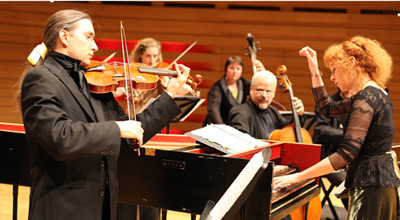by Nicholas Jones

At the heart of this performance were the programmatic qualities of the music — its depiction of seasonal life in the Italian countryside, complete with birds, dogs, shepherds, and lots of weather. Drawing on the pastoral depictions of 18th-century landscape painting, Vivaldi wrote into these concertos a richly pictorial set of soundscapes, from birdsong and bagpipes to gunshots and thunderstorms. The composer even wrote (or commissioned — we’re not sure) four sonnets to narrate the “program,” and quoted them in the score to highlight the imitative moments.
Brault and music director and harpsichordist Jeannette Sorrell took every opportunity in the music to “read” Vivaldi’s programmatic intentions across to the audience. Pretending to be the gnats of summer, the back stands of violins played vigorously on top of the bridge, creating an appropriately loud and annoying sound. Passages depicting the storms of summer and the winds of winter were played with obvious and delighted virtuosic zing — rapid scales for lightning, fast repeated notes deep in the string for thunder, and swirling passagework for the winds.
Everywhere, this landscape was full of motion — galloping hunters, murmuring streams, unsteady peasants on an icy path. Even the harvest siesta — the middle movement of “Autumn,” with its muted strings playing sustained, slow-moving harmonies — maintained the performance’s restless energy with Sorrell’s improvised addition of elegant and dreamy harpsichord arpeggios.
The programmatic excitement came from a deliberate and forceful use of contrast. Dynamic changes were dramatic: Brault and the lean band of string players backing him showed that they could turn on a dime from the quiet song of a nightingale to as much storm and stress as a baroque orchestra could hope to muster. Backing these frequent and abrupt contrasts were Sorrell’s always-interesting harpsichord work, René Schiffer’s witty and thoughtful cello playing, and the animated guitar and theorbo playing of Simon Martyn-Ellis (an inspired addition to the continuo section).
The solo part in these concertos is technically quite demanding, not in the manner of a big Romantic concerto, but with episodes of complicated double stops and fast passagework. Brault (who also serves as concertmaster for Apollo’s Fire when not in the solo role) played with flair and intelligence, attending to what the hard parts meant in the larger programmatic context, and delivering them with cleverness and fervor. Some inaccuracies of intonation in his playing in upper registers and faster passages were understandable consequences of the group’s decision to emphasize the emotional and dramatic contrasts of the music.
Apollo’s Fire has built its deserved reputation not only on musical excellence, but also on its commitment to making baroque music understandable to modern audiences. Not the least of the tools for this is Sorrell’s skill at speaking to the audience. Here, she described the programmatic essentials before each concerto and asked the band to play snippets of the musical motifs that were to represent the incidents of the story. It’s not easy to keep that kind of introduction short and to pitch it at the right level. She did, to excellent effect.
Like much pastoral art, The Four Seasons pretends to live amidst fields and flocks, while in reality it is a product of sophistication. The urbane Venetians for whom Vivaldi composed — and who heard the concerts of the elegant and accomplished orphans of the Pietà — had never worked a harvest nor danced to a bagpipe.
We were reminded of that other side of Vivaldi’s world by the inclusion of his wonderful D minor Concerto for Two Violins and Cello (op. 3, no. 11), which lacks any program, rustic or otherwise. Showing individual brilliance as well as impeccable ensemble in the solo slots were Apollo’s Fire regulars Johanna Novom and Julie Andrijeski, violins, and René Schiffer, cello. Novom’s clear, centered tone was especially effective in the cantabile second movement, in which the other two soloists retire to the ranks of the orchestra while the first violin carries the tune. Given the intellectual nature of the concerto (a full-scale fugue in the first movement!), it’s no wonder that it was this work (and not the bumptious enthusiasms of The Four Seasons) that so impressed J. S. Bach.
A break from Vivaldi came midway through the program, in the form of a selection from a suite commissioned from René Schiffer for Earth Day some years ago. (Schiffer writes under the name of Duchiffre.) The first of the two movements, a sinfonia on the hymn-tune, “For the beauty of the earth,” added a “green” awareness to Vivaldi’s nature writing. It was followed by a chaconne that caught much of the spirit of the French baroque.
Responding to a warm ovation at the end of the concert, Sorrell added an encore, the upbeat Irish dance known as “Carolan’s Favorite Jig.” Announcing the piece, she noted that she chose it in honor of Hugh Carslaw, who recently moved to Cleveland from Ireland to become Managing Director of Apollo’s Fire.
Published on ClevelandClassical.com April 21, 2015.
Click here for a printable copy of this article



